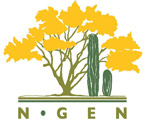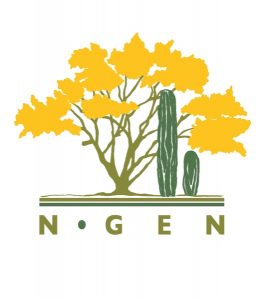Robert Villa, Tucson Herpetological Society
I was six or seven years old when I entered my great-grandmother’s kitchen in South Tucson and noticed a yellow Tupperware box in the corner. Peering in, I was captivated by a desert tortoise. And when we offered it some lettuce my fate was sealed as a herpetologist. I became transfixed by watching this fascinating creature chomp into the leaves. The path up to the age of 29 has seen me search out the world of the Sonoran region and its scholars and admirers, and collect memorable and meaningful experiences.
One of the vehicles for this occurred through the Madrean Archipelago Biodiversity Assessment (MABA) administered and funded by Sky Island Alliance, and the Veolia, and Greater Good foundations until very late 2014. Led and directed by Tom Van Devender and his wife Ana Lilia Reina-Guerrero, the six year program sought out to survey and report on the fantastic biodiversity in the 60 or so sky islands in Sonora and Arizona and upload digital vouchers to the public MABA database at www.madrean.org. These trips engaged three Mexican universities, CONANP, local ranchers, and various US volunteer specialists; from independent researchers to various universities and environmental groups/agencies. It was common to have up to 40 or more participants on some trips, replete with a base camp and cooks.
In 2014 two MABA expeditions documented the Sierra Huerfana, previously known as the Sierra Mazatán, some 22 km east of Hermosillo. The former name means “orphan” in Spanish, being christened as such because of a small ownership feud between the three towns that surround it.
The first MABA trip was in April during the spring dry season. As a herpetologist I had little hope for outstanding herpetological novelties since very few specimens would be active before the monsoon rains. This would indeed fuel my formative infatuation with field botany. During the first day of exploration I was with Jesús Sanchez (Curator, University of Sonora Herbarium, http://herbario.uson.mx) and his team of undergraduates. While much of the vegetation was dormant we could still appreciate a large willow oak, a new nopal awaiting description in flower, as well as a showy Anisacanthus andersonii, and a mystery succulent vine. As we neared the end of our hike we sat at the head of a boulder-filled granitic canyon. Looking to the horizon I noticed the unmistakable silhouette of one of the botanical treasures of the region: the cycad, Dioon sonorense. Locally known as “peine”, Spanish for “comb” for the shape of the leaves. Known in other places as “palma de la vírgen”, Spanish for “palm of the virgin [Mary]”. I excitedly pointed this out to the group and it was a mad dash for the steep, thickly vegetated, southerly-exposed ledge they were growing on.
Stephen Hale and George Ferguson were beating us to the chase! Alas, student Marína, CONANP ranger Chobi, and I arrived first and proudly admired the new population we had just discovered. Stephen and George arrived as we began to count and properly document the “living fossils” that lay before us. This was a new patch of these plants to add to the known locales in the Sierra Huerfana. Recent work indicates that this species, endemic to Sonora and Sinaloa, is indeed comprised of two distinct genetic and environmental units warranting protection.
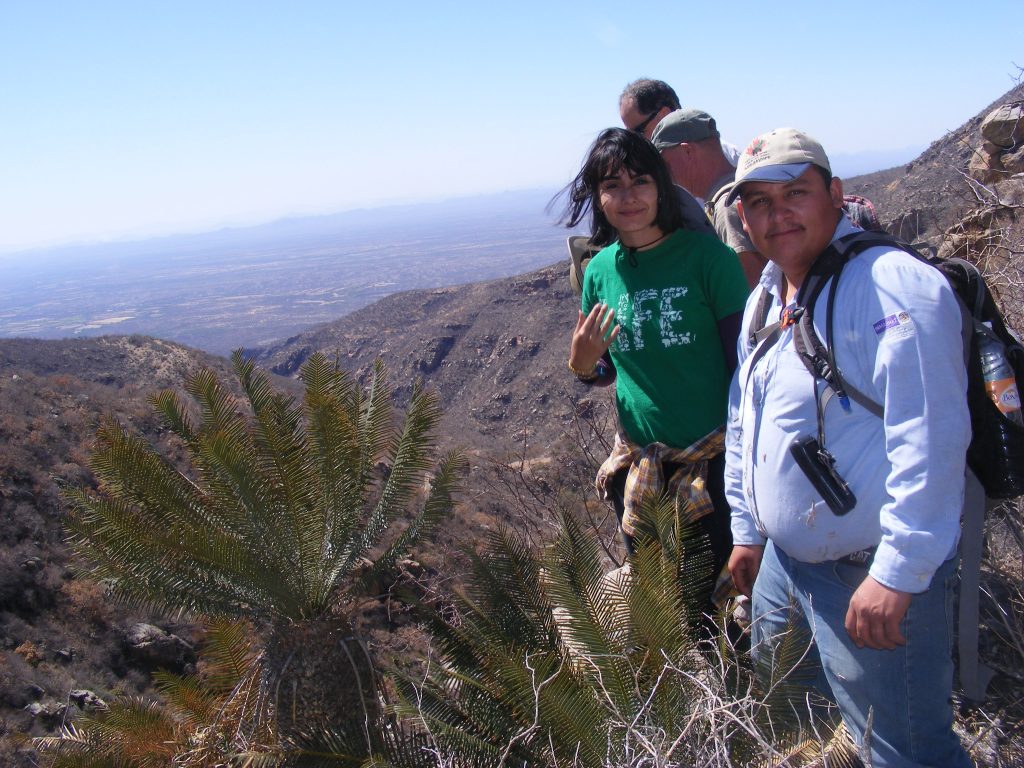
Marína, Choby, George, and Stephen admiring the cycads
Cycads have remained unchanged since the Jurassic period (sometimes called the “age of cycads”) and are found worldwide in tropical regions. They are long-lived dioecious plants – plants are either male or female, which take up to 80 years to reproduce via cones. The population in the Sierra Huerfana is along the northern edge of the tropics in the Sonoran region where temperate and xeric biota converge. In his comprehensive book on cycads, Loran Whitelock cites an unknown source claiming that for a period of time Sonorans heavily exploited cycads for their starch-rich trunks for food and/or for distilling into alcohol.
After this exciting discovery, the unique assemblage of vegetation became more apparent, and my botanical curiosity was piqued even more. George, imitating an interested bee, agitated the anthers of the nopal with his finger and they instantly contracted towards the pistil, dusting his finger with pollen. I noticed epiphytic Tillandsia; both temperate and tropical ocotillos growing together; saguaros growing amongst oaks; a sandy arroyo dominated by spider lilies and nopal; tropical kapok trees within a few hundred feet of saguaros; temperate desert spoon growing alongside tropical Burseras and Plumerias.
Every day of the expedition I returned to this canyon named El Yugo, venturing farther down each time, crawling around and over boulders, skirting tinajas, grappling rock walls sporting the lovely Agave ocahui var. longifolia, and falling ever in love with plants.
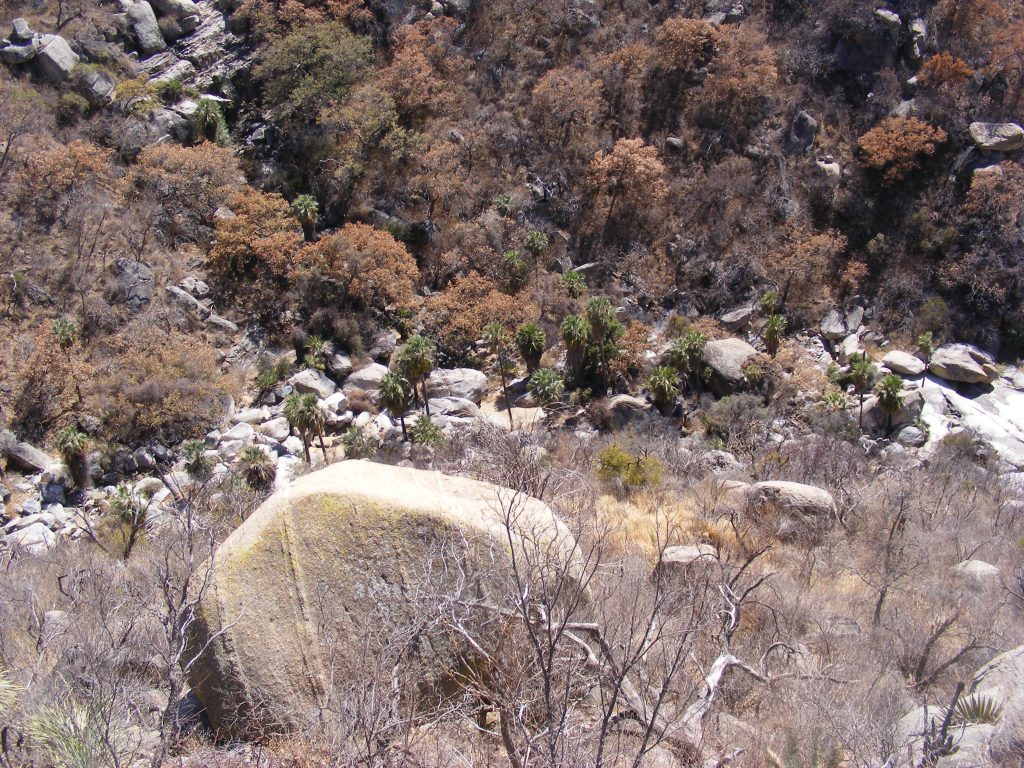
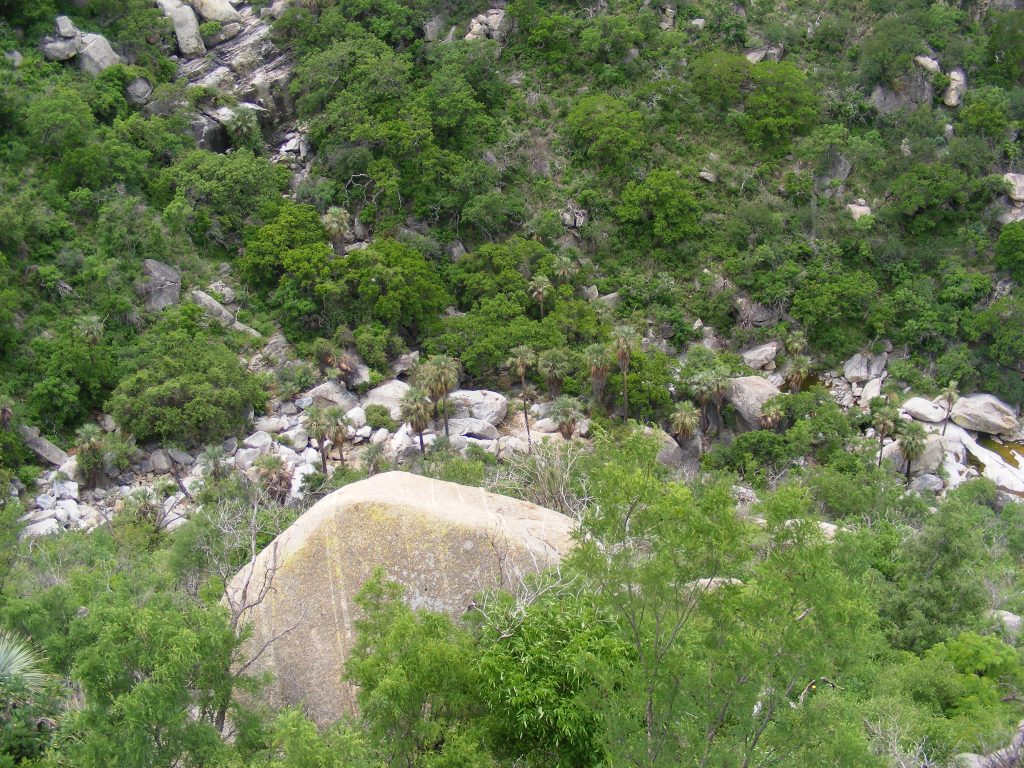
Dry (April) and wet (July) season aspects of the Sierra Huerfana from the precipice where the cycads grow
This trip was also a part of the effort to elaborate the biodiversity of the mountain to gain federal protection under CONANP. We left with every intention of returning during las aguas.
Indeed we returned in July on the night the surrounding towns met to approve the mountain’s federal status as a natural protected area. The mountain was verdant and brimming with life, and frequent distractions on the way up had us pull over and photograph the biotic cornucopia presenting itself. Coral pink ground orchid flowers, maroon-black milkweed flowers, mud turtles, black and white wood creepers, and gartersnakes. I knew the official westernmost population of spotted box turtle occurred here, and indeed three were seen. Two were observed rummaging through cow dung. Something new for this species, but well known in North American box turtles. Someone even scrounged up a lovely indigo snake.

Terrapene nelsoni
As before, I took pleasure in visiting El Yugo every day and taking photographs from the same position at the same patch of land that I did in April. Climbing back up to the cycads through almost impenetrable greenery, I stumbled upon a desert tortoise fattening itself on the luxuriant forest of annual herbs not 10 almost vertical metres from the cycads. I learned that the mystery succulent vine I observed in April was in fact a Cissus, now with leaves. This lovely vine in the grape family (Vitaceae) now adorned the canyon walls with its heart-shaped leaves. Later on we noticed a large blooming shrub brimming with pendulous sweetly aromatic flowers. What I excitingly thought was a northern specimen of wild coca turned out to be Sonoran persimmon as Tom explained. I was enamored nonetheless.
The next two days were to be spent in the Sierra Murrieta, a range in a vast limestone shield encompassing a few municipalities in the eastern side of Sonora near Bacanora. En route east from the Sierra Huerfana we wound through the precipitous hills vegetated with increasingly tropical vegetation. At one point we were forced to stop and admire dashing Manihot trees screaming at us from the roadside and adjacent forest with its papery-barked red stems and glaucous palmate leaves.
Arriving at dusk to the whimsically named Rancho Toribusi, we passed through a grove of Mexican blue palms while my mind danced with the known records of secretive black banded geckos, spotted box turtles, and one of the rarest and elusive lizards in North America: Ditmar’s horned lizard (Phrynosoma ditmarsi).
We awoke at the top of the range in a palm-oak forest sprinkled with oak pipevine, fragrant kidneywood, and begonias growing on mossy patches in the arroyo. My good friend Sky had been up before breakfast and arrived to show us a curious flower he found while listing birds: an as-of-yet unidentified Calochortus in the C. barbata complex.

Sky Jacobs with the undescribed Calochortus
Beginning our hike, I admired flowering arborescent Nolina matapensis, majestic Yucca grandiflora, and the purple rust flowered Dasylirion gentryi. Descending into a limestone flat we encountered the diminutive Agave parviflora flexiflora, as well as an unassignable species. As we walked through patches of this diminutive Agave, Ana Lilia remarked we were walking through a miniature forest in girlish delight. Photographer and excellent herpetologist Erik Enderson photographed the endemic hedgehog cactus Echinocereus bristolii.
On the second morning while contemplating the identity of a curious shrub, something small fleeted from the corner of my vision. I instantly knew it was a horned lizard, and just as excitedly shouted “ditmarsi!” Indeed this was the first time I had beheld this herpetological gem, as it was for Tom despite his decades of work in Sonora. A tiny specimen no more than 3 cm, our moment became more special when Ana Lilia caught what was very likely its mother a few feet away. Unlike most horned lizards, this species gives birth to live young. On a previous MABA trip we expanded the known distribution of this species to total only 9 locales restricted to the state of Sonora. More than 70 years had passed since only the second specimen had been collected. The first one being collected on Carl Lumholtz’s exploits in Sonora in 1897. It resides in the herpetological collection of the American Museum of Natural History in New York. It took much historical and scientific sleuthing by the late Vince Roth to approximate the collection locale of that first specimen which would lead to the second collection of the species.
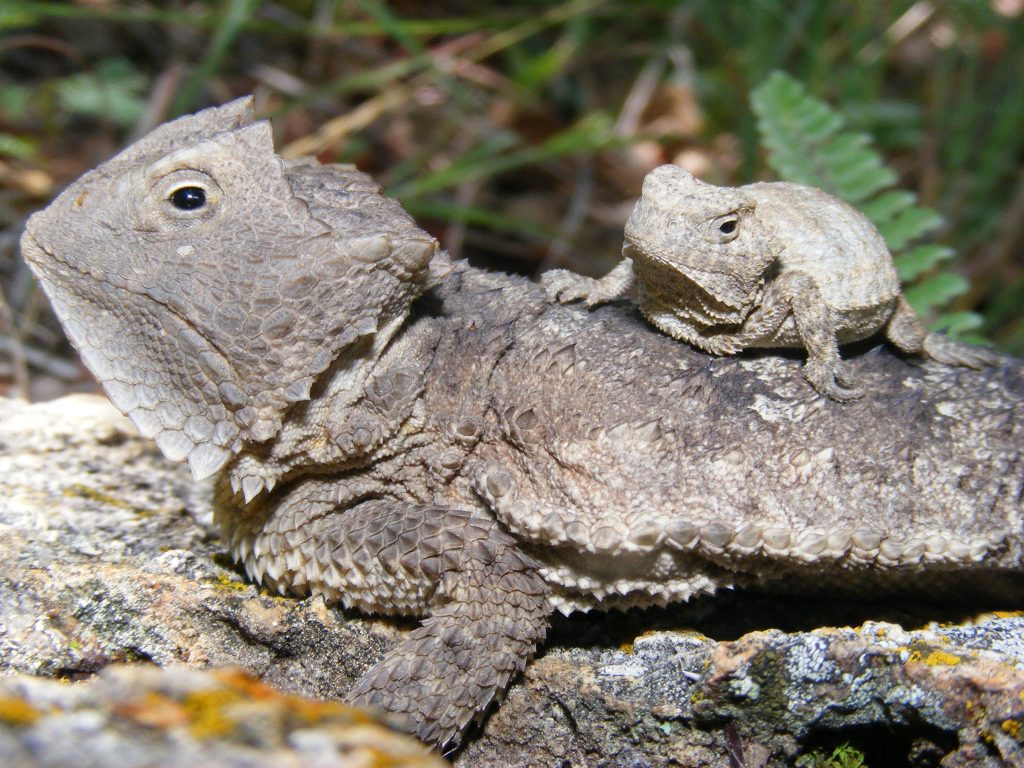
Phrynosoma ditmarsi
All that you have read is part of my ever-growing biophilia. There is however a curious trend to be noted: the herpetological beginnings of a few Sonoran botánicos. Beginning with venerable Paul S. Martin and his master’s thesis on the biogeography of the herpetofauna of the cloud forest at Gómez Farías, Tamaulipas. His exploits at the University of Arizona would include taking his students into southern Sonora in the footsteps of the great Howard Scott Gentry, first explorer of the Río Mayo flora. Gentry partially funded his expeditions by collecting biological specimens for museums across the nation; leading him to collect the type specimen of the Yaqui black-headed snake. Paul Martin’s student Tom Van Devender would evolve from a herpetologist into a pioneer paleobotanist and ecologist in the Sonoran region through fossil packrat midden analysis, and eventually field botanist and landscape ecologist. Mark Dimmitt likewise had a herpetological background before becoming a botanical and horticultural expert. Last but certainly not least, the dean of Sonoran ecology, Charles H. Lowe, more aptly known as a herpetologist, published a three-volume treatise on the ecology of saguaros with Warren F. Steenbergh.
My love of the Sonoran region and the tradition of exuberant biological expeditions into it grow with each trip to, and publication about it. Arguably begun by Howard Gentry in the 1930s and continued by many naturalists up to the recent MABA expeditions, the importance of biodiversity documentation cannot be overstated. Apart from being an important aspect of culture and quality of life for many of us in the Sonoran region, there is a need to establish a long-term perpetuation of these multifaceted, multinational expeditions into the Sonoran campo to elaborate its fantastic biota, and awesome landscapes.
